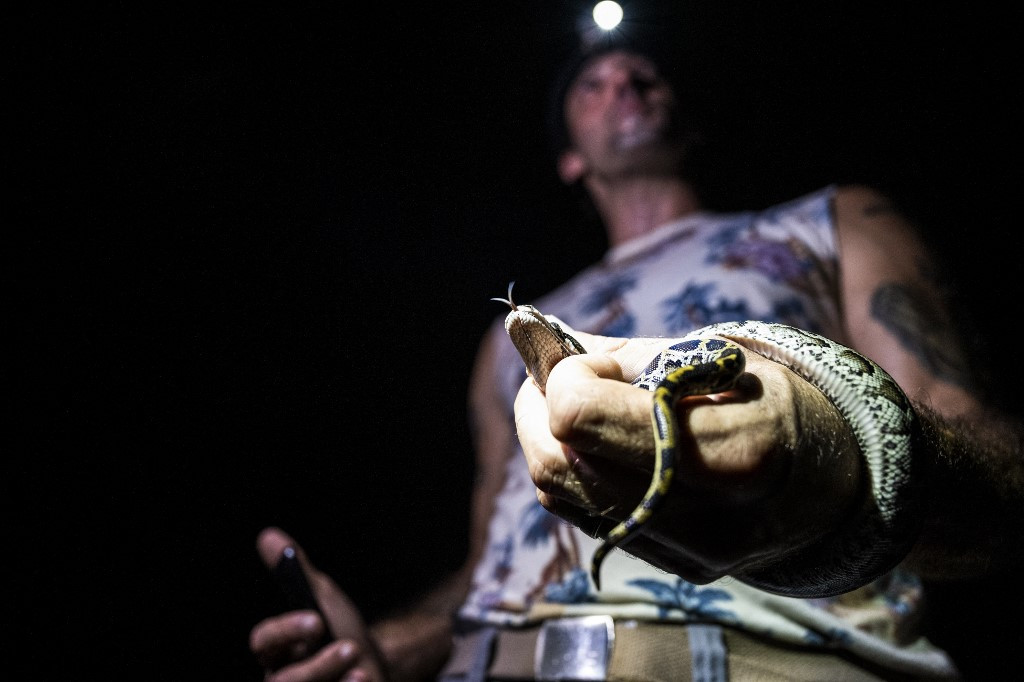Gerard Martinez (AFP)
Miami, United States ●
Wed 24 Aug 2022
Rarely is Enrique Galan happier than when he disappears deep into the Everglades to hunt down Burmese pythons, an invasive species that has been damaging Florida’s wetland ecosystem for decades.
When he’s not working on his job organizing cultural events in Miami, the 34-year-old spends his time tracking down Southeast Asian nocturnal reptiles.
He does so as a professional hunter, hired by the Florida Fish and Wildlife Conservation Commission (FWC) to help control the python population, estimated to number in the tens of thousands.
At night, Galan drives slowly for miles on paved roads and gravel tracks, her flashlight playing on grassy edges and tree roots, and the banks of waterways where the eyes of alligators sometimes shine.
He charges $13 per hour and an additional fee per python found: $50 if he is up to 1.2 meters and $25 more for each additional foot.
But on this August night, he has an extra motivation.
The FWC organizes a 10-day python hunting competition, which is attended by 800 people. The prize is $2,500 for whoever finds and kills the most pythons in each of the categories – professional and amateur hunter.
And Galan would like to earn this money to celebrate the arrival of Jesus, her newborn baby.
Pets released into the wild
Burmese pythons, originally brought to the United States as pets, have become a threat to the Everglades since humans released them into the wild in the late 1970s.
The snake has no natural predators and feeds on other reptiles, birds, and mammals such as raccoons and white-tailed deer.
“He’s an incredible predator,” says Galan admiringly.
Everglades specimens average between six and nine feet long, but finding them at night in the more than 1.5 million-acre (607,000-hectare) wetland takes skill and patience.
Galan has a trained eye, as well as the courage and determination needed for the job. After two fruitless nights, he spots a shadow on the shoulder of Highway 41: he jumps out of his truck and throws himself at the animal, a baby Burmese python.
Seizing it behind the head to avoid being bitten, he puts it in a cloth bag and ties it with a knot. He will kill him hours later with a BB gun.
A few kilometers further, a huge python slides on the tarmac. Galan jumps out of his truck again but this time the snake escapes into the grass, leaving behind a strong musky smell, a defense mechanism.
therapy for some
Galan took online training before hunting pythons, but says he learned everything he knows from Tom Rahill, a 65-year-old who founded the Swamp Apes Association 15 years ago to help veterans cope with traumatic memories through python hunting.
For a few hours, Rahm Levinson, an Iraq War veteran with post-traumatic stress disorder, hunts with Rahill and Galan.
“It really helped me overcome a lot of difficulties at home,” he said.
“I can’t sleep at night and having someone to go out at noon, two in the morning and catch pythons is productive and good.”
Galan is proud to be part of a project that has eliminated over 17,000 pythons since 2000.
“One of the best things I take away from it is the amount of beauty that surrounds me. If you look closely, open your eyes and observe, you will see a lot of magic here.”

